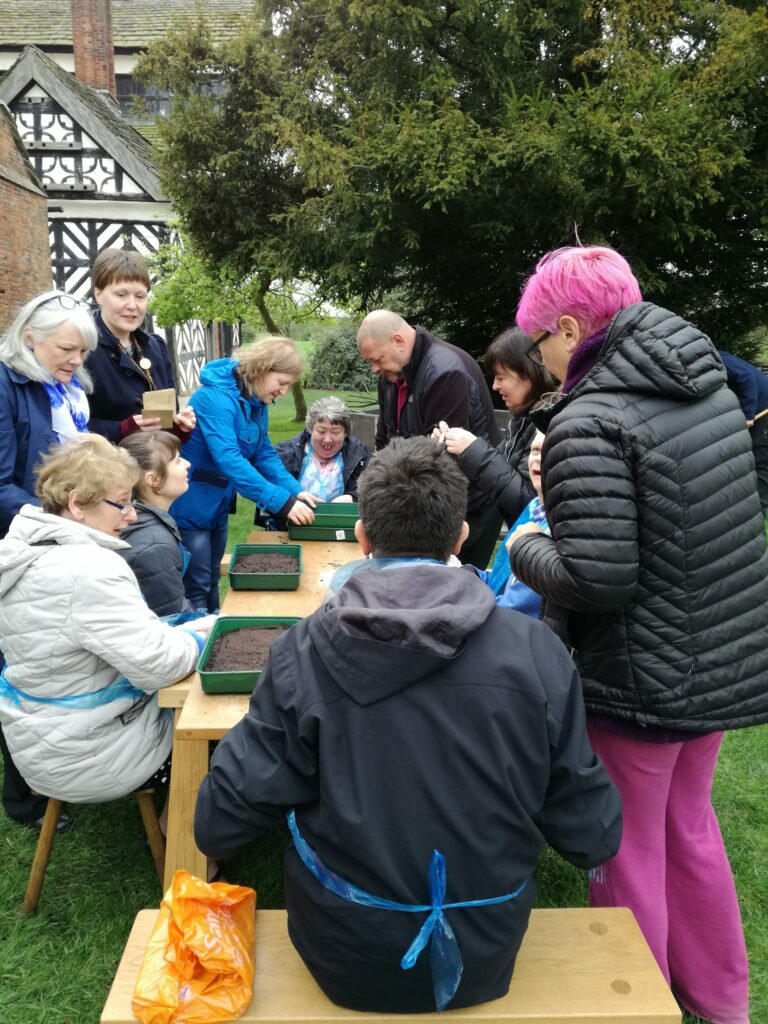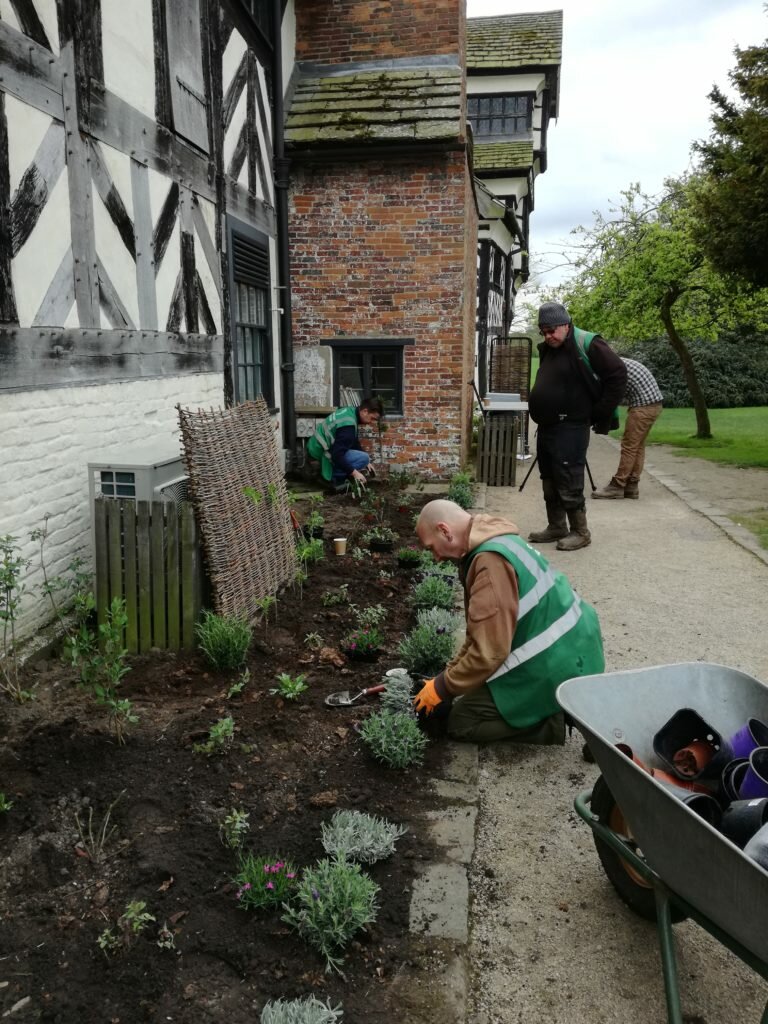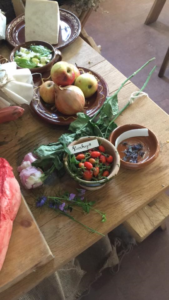A couple of weeks ago, with the help of our friends and colleagues at Carter House Day Centre and Cheshire East council, we completed the initial planting of our early modern sleep bed at Little Moreton Hall. The sleep bed was carefully designed by the service users at Carter House Day Centre. As well as being instrumental in the conception and installation of the sleep bed, they will also be producing their own mini replica of the garden back at Carter House. From lavender and roses, to poppies and violets, we planted an array of herbs, flowers, and shrubs that early modern people believed aided sleep. But what was it about these plants that convinced the people of the sixteenth, seventeenth, and eighteenth centuries that they would help their pursuit of a sound night’s sleep? In this post we explore some of the ideas behind these soporific ingredients and the ways in which they were used to treat early modern sleep loss.

What was sleep for?
To understand why early modern people believed that plants could aid their slumber we must first understand what they thought the function of sleep was. By the end of the period two theories coexisted, one that linked sleep to the process of digestion, the other to the brain and nervous system’s vitality. Within both of these theories, the regulation of body heat was central to the onset of good quality, restful sleep. Should the body overheat during the night, either in the stomach or in the brain, sleep would be interrupted and the body prematurely awoken. Without the requisite amount of sleep, food would remain undigested, the nerves would become disorderly, and the body’s spiritual and physical health would be thrown into disarray. Medical understandings of sleep’s function thus ensured the popularity of plants and herbs that appeared to cool the body thereby ensuring peaceful slumber and restoring disrupted sleep.[1]
Cooling Soporifics
In humoral conceptions of bodily health, individual bodies were believed to have specific elemental make-ups, so too were different foods. A person’s ‘complexion’ or humoral temperament was shaped by their own particular balance of humours. These humours – blood, phlegm, black bile, and yellow bile – had different elemental qualities. Blood was believed to be hot and moist, phlegm cold and moist, black bile cold and dry, and yellow bile hot and dry. Those of a sanguine complexion, for example, were believed to possess an excess of blood, meaning that their bodies were naturally hot and moist. For melancholics, the temperature and humidity of their bodies was the opposite. Their abundance of black bile left their bodies naturally cold and dry. In a similar fashion, different foods were categorised by their individual elemental composition; pepper was hot and dry, whilst fish was cold and moist.[2] In order to maintain your natural complexion, physicians of the era encouraged people to consume foods that possessed a similar quality to their own complexion. According to the English physician Thomas Elyot, an individual’s complexion is ‘conserved in his state, by that which is lyke therto in fourme and degree’. Following this logic, Elyot advised that ‘to them whose naturall complexion is moyste, ought to be gyven meates that be moyste in vertue or power’ whilst those whose complexion is dry ‘ought to be gyven meates drye in vertue or power’.[3]
Because of this strong connection between the qualities of food and the maintenance of humoral balance in the early modern period, the list of ingredients that were considered to have a cooling effect was extensive. It included, but was not restricted to, chamomile, cucumbers, poppy, lettuce, and eringo roots (sea holly), all of which were used to aid sleep. Other ingredients that were believed to dissipate excess heat in the brain and stomach, and therefore treat sleep loss, included aniseed, rose, violet, lavender, lily, parsley, saffron, dandelions, and onions. As well as their cooling properties, many of these ingredients were also prized for their calming effect on the mind. The somniferous scents of rose, violet, and poppies helped calm an anxious mind, which was a common cause of sleep loss. Some of these ingredients could be cultivated in kitchen gardens, like ours at Little Moreton Hall, whilst others could be easily purchased from groceries and apothecaries.[4]
Concocting a Remedy
A variety of remedies were concocted using these cooling and calming ingredients in the early modern period. Many appear in recipe books of the era as cooling liquids, syrups, and possets. Essex clergyman Ralph Josselin, for example, used both ‘carduus posset’ – a hot drink steeped with Carduus thistle – and a ‘sirrup of roses’ to help him sleep better.[5] These syrups, distillations, and conserves could be drunk or externally applied to the body, most commonly on the head, neck, and temples. Other remedies were slightly wackier. In a recipe from a book belonging to the family of the philosopher Robert Boyle, a concoction of aniseed and rose water was recommended to treat sleep loss. Rather than consuming the mixture, or applying it to the temples, the recipe advised to place the ingredients in a string bag which should then be tied to the upper lip. The logic was that the ingredients in the bag would give ‘a cold smell and procureth sleep’ as the fumes entered the nostrils and infused through the brain during the night.[6] Another sleep remedy from the early eighteenth century seemed equally uncomfortable, and potentially malodorous. It advised the sufferer of poor sleep to comb up their hair ‘with vinager and nutmeg’ before bed.[7] How this would help you get to sleep was seemingly left to the imagination of those willing to give it a try! Once our early modern sleep plants have matured at Little Moreton Hall, we will be trying some of these sleep remedies out for ourselves. We will, of course, let you know how effective (or possibly ineffective!) they are!
Whilst some of these concoctions may seem strange to us today, many of the ingredients used by our forebears to treat sleep loss are still considered to have considerable soporific effects. Just take a look at many of the remedies you can buy today, from balms, oils, and bath soaks that contain lavender and rose, to pillow sprays that contain calming aromas of chamomile and bergamot. So the next time you settle down to a cup of chamomile tea before bed, remember that this sleep remedy is already hundreds of years old!

* * *
Want to learn more about early modern remedies and maybe try some out for yourself? Check back soon to see our compilation of early modern sleep recipes and visit us at Little Moreton Hall to find out more about early modern soporifics!
[1] Sasha Handley, Sleep in Early Modern England (New Haven and London: Yale University Press, 2016), 20-38.
[2] Ken Albala, Food in Early Modern Europe (Westport, CT: Greenwood Press, 2003), 215-216.
[3] Thomas Elyot, The Castel of Helth (London, 1539), fols. 17-18.
[4] Handley, Sleep in Early Modern England, 63-67.
[5] ‘Ralph Josselin’s Diary’, cited in Handley, Sleep in Early Modern England, 64.
[6] ‘Boyle Family Recipe Book’ (c. 1675-1610), Wellcome Trust MS 1340, fols. 17, 122, 132.
[7] ‘A Book of Phisick’ (1710), Wellcome Trust MS 1320, p. 107.
